0 to 1,000+ mailing list subscribers

In this guide, we cover how to build a mailing list from scratch and using it to find reviewers and increase sales. This guide also walks through reader magnets, welcome sequences, cross-promotions, and all of the tools you need to get started.
First, let's examine a few things about the current marketing landscape for authors:
This sounds pretty bleak, but there's still hope!
The above and below reasons are why many authors choose to build a mailing list.
This power comes from the fact that with a mailing list, you own a direct line of communication to your fans that you control (unlike Facebook or Amazon followers that you can't directly contact).
Many authors also love getting fanmail back from their mailing list subscribers, who provide motivation and serve as a "tribe".
Below is just a small sample of quotes from authors about their mailing lists.
[My email list] allowed me to generate reviews and launch the book to the #1 new release in Gaslight Fantasy for the first week of release. - Danny Santos
My sales on newsletter swap days surpass those on ad days. - Toasha Coggins
My mailing list is a major component to the marketing of my book! Without it, I would be dead in the water. - Caleb Fast
Growing a mailing list is key to becoming a successful writer for several reasons: Increasing the # of pages read on Kindle Unlimited, improving the sell-through of a series, and creating an audience to whom you can pre-sell your next book! - Michael Angel
We know mailing lists can be useful, so step 1 is figuring out how we can get people to sign up.
The answer is straight-forward: Give people a reason.
Entice readers to join your mailing list and show them what they'll get.
Most authors do this in the form of a “reader magnet” - a story that you give away to anyone who signs up to your mailing list.
If you write fiction, I recommend a 10-20K word short story prequel to your book or series.
I was very specific with that definition, so let's dig into it.
Why use a prequel?
Why 10-20K words?
If you write non-fiction, there is a much broader range of what might work dependent on what your main focus is as a non-fiction author (e.g., diet plans, workout schedules, a short guide like this one, etc.)
Regardless of what you use as a reader magnet, remember this may be your first piece that someone reads.
It still needs to be well-edited and have a good cover. The good cover is especially important to getting anyone to request it in the first place.
Why not use a sample?
There are two main issues as I see it.
First, giving readers a sample and trying to sell them on buying the full book might make readers feel like they were tricked into signing up to your mailing list.
No one wants to feel like a sucker.
Give people lots of value. Be generous with them, and they are more likely to be generous with you.
Second, samples may also make it harder to “hook” the reader into getting the rest of the story or series.
You may not have a great cliffhanger at the same point where it would be normal to cut off a sample.
With a reader magnet purposely written to hook readers in, you have the opportunity to write the best cliffhanger possible.
All this isn't to say that you should never use a sample as a reader magnet. Lots of authors have done this and been successful with it.
It's worth spending some time thinking about what's right for your situation.
If your book is enrolled in KDP Select or Kindle Unlimited, then you have agreed to an exclusivity clause that states the digital version of your book will solely be distributed by Amazon.
However, according to the KDP knowledge base you can distribute a sample version of your book containing up to 10% of the book (essentially the length of the sample that anyone can view on Amazon before purchasing).
We know how we're going to attract readers to sign up for our mailing list, but how do we actually go about sending subscribers newsletters?
Gmail (et al.) accounts have usually have a limit of sending up to a few hundred emails per day, and we're trying to reach 1,000+ subscribers, so sending emails directly from there isn't going to work.
That's where an email service provider comes in handy.
Email service providers are designed specifically to store mailing lists, send campaigns, and comply with marketing regulations (e.g., GDPR and CAN-SPAM).
You'll also need to figure out what email address you want to use to send your newsletters.
You can use an email service provider to send emails from your Gmail (et al.) email address or from a custom domain email address (e.g., penname@penname.com).
It's not strictly necessary, but a custom domain email address is extremely beneficial.
When you send emails from a Gmail, Yahoo, Hotmail, etc. address, your newsletters are much more likely to be marked as phishing campaigns.
That means your email will end up subscribers' spam boxes and never be seen.
Plus, emails coming from a custom domain look substantially more professional, and you want your readers to hold you in high regard.
If you plan to set up a custom domain, the Action Steps below will provide you with the steps necessary to do so.
It may sound like a lot of work, but overcoming these early hurdles significantly increase the long-term chances of building a successful author business.
Done writing your reader magnet and setting up your email service provider? Wow! That was fast!
Now, you need to figure out how to:
Tired already from thinking about how much time that will all take?
That's where tools like StoryOrigin come into play.
StoryOrigin provides a feature specifically for reader magnets that does all of the above for you.
It doesn't take more than a few minutes to get it set up and be on your way to the more important stuff: promoting your reader magnet.
There are a number of avenues you can use to promote the link to your reader magnet landing page: Facebook ads, blog posts, links at the back of your book, etc.
Each of these have their own benefits, but the one catching on quickly with many authors is cross-promotion. Why? Because it's:
A cross-promotion is where two sellers agree to promote each others' products and they come in a variety of forms, but the two most common among authors are “newsletter swaps” and “group promotions.”
These cross-promotions effectively multiply your reach and can be used for a variety of goals: to build your email list, increase sales and page reads, or find reviewers.
At this stage, you'll be most interested in group promotions used to build your mailing list. These are called “Giveaways.”
To set them up, you'll want to:
You can do all of this through some combination of forums, your own website, and tracking links (which can be time-consuming).
Or, you can find and arrange both newsletter swaps and group promotions directly on StoryOrigin, which handles all the infrastructure you need.
Absolutely!
Many of the authors you might find to run newsletter swaps or group promotions with on StoryOrigin were just in you shoes a few weeks or months ago.
Organizers are usually more than happy to accept authors with 0 subscribers into their group promos knowing that everyone has to start somewhere.
If you have 0 subscribers, you should start with the Action Items in the "How do I promote my reader magnet landing page?" section.
As soon as possible! You can (and should, if possible) start before you've even released the follow-up book or series.
Why?
First, launching your book to a waiting audience will improve sales in those initial days, which juices the Amazon algorithms to show your book to more readers.
Second, you gather interest from your mailing list subscribers to see whether they would like beta copies or review copies of the follow-up book before it's released.
Third, building your email list takes time, patience, and determination.
Even if you fast-track your list building by spending loads of money on raffle prizes and ads, it still takes time to establish a relationship with your audience.
Building your rapport with readers is incredibly beneficial, so let's get into it.
This is a huge topic, but here's how I imagine it: you go to hang out with a few friends, and you bring along a new friend that no one in your circle knows.
Do you count on your new friend to make themselves part of the conversation? No, you engage them and bring them into the conversation.
Make them feel like they're part of the group. How?
Just remember to treat your subscribers like you're in this situation when you're drafting your newsletters. They're human too!
How does this framing affect your newsletter?
Just to stress the first point above: I suggest having a specific person in mind when writing your newsletter. Pretend like you're writing just to them.
The person you pick to pretend like you're writing to them should generally be an archetype of your reader (e.g., old, young, clean, crass, etc.).
Once you have the proper framing or perspective on writing your newsletters, it's time to figure out the various components to a newsletter.
Most email service providers give you the ability to trigger a sequence of emails that will go to the reader when they sign up to your mailing list.
Generally, you'll have the first email in the sequence triggered to be sent out when the reader is added to your mailing list.
Each subsequent email in the sequence can be sent a day apart or weeks apart depending on your goals, backlog, regular newsletter frequency, etc.
Generally, you have a few goals with your welcome sequence:
Let's get a little deeper in the weeds on those.
Providing a download link for your reader magnet
If someone subscribed to your mailing list by requesting a reader magnet you had hosted on StoryOrigin. Then, StoryOrigin will automatically provide them with a download link and handle the file delivery.
However, you may have many readers subscribe to your mailing list via other means (your website, an ad, etc.).
To make sure those readers get the same offer everyone does, it's always good to have a link to download your reader magnet in a welcome sequence.
StoryOrigin has a specific feature for these welcome gifts: Direct Downloads.
Figure out who is going to actually open emails
There will be people who subscribe to your mailing to get the book you have to offer, then never open a single one of your emails.
Sometimes it can feel like these readers are taking advantage of you.
Don't let that feeling get to you.
Remind yourself to lead with generosity. You're playing the long-game.
One of the key components to your welcome sequence is figuring out who will and who will not open emails.
If you've got a 3, 4, or 5 email welcome sequence spread over a week or two, and someone doesn't open a single email. It's highly unlikely they'll open future emails.
Since most email service providers charge you based on the number of subscribers, it can be costly to keep non-openers on your mailing list. It can also be demoralizing to have low open and click rates.
Given these factors, it's best to remove subscribers that don't open your emails from your mailing list.
Figure out who might be your champions
Mailing lists are a great way to find readers that will champion your work.
They might want an early review copy of your next book before it's published, or they might want to beta read your next book, so they can get a mention in your acknowledgements section.
Part of your welcome sequence can include asking readers that join your mailing list to
What is double opt-in to begin with?
Double opt-in means that when someone signs up to your mailing list, you send them an email right off the bat asking them to confirm that they actually want to be on your mailing list by clicking a button in that email.
If they don't click that button in the first email, then a few things may happen (depending on your email service provider):
Why would I want to use it?
Authors like to use double opt-in as a way to prevent readers their list becoming bloated by people that sign up, but that never open any emails.
This is essentially the same purpose as your welcome sequence, but comes with the downside that missing just that intial email means they'll get another from you.
For that reason, I recommend turning double opt-in confirmation off and instead using your welcome sequence to weed out non-openers as described the previous section.
We know what we're looking to get out of our welcome sequence, so how should we structure it?
Below is an example sequence. Take it, leave it, modify it. Make something that has your voice.
Email #1
Email #2
Email #3
Remember, this is only an example and is by no means the best structure for you or your goals.
You may not have a Facebook Group; or, you may not have review copies of your first book ready to go; etc.
You might want to consider spacing your onboarding emails a day apart, so that it's faster to onboard new readers, figure out whether they're non-openers, and may make a stronger first impression.
A stronger first impression means they are more likely to remember you later.
Remember, the general idea is to:
Once you've established a relationship with your readers, it's important to keep them engaged.
If you go 6 months between emailing your list, it's likely that quite a few of your subscribers might have forgotten what books you wrote.
Alternatively, if you email subscribers every single day, they might feel like you're pestering them.
It's also important to take a step back from what your individual tastes are and to be very skeptical of anyone's estimates of their own preferences.
This is one area where I would say you shouldn't poll your subscribers.
If you want to know which frequency works best for you, experiment and look at the results. Don't trust survey responses.
Of authors that have experimented with various frequencies, it seems that once per week or twice per month generally results in the highest open and click rates.
Once per month is generally good as well but may result in slightly lower open/click rates.
There are lots of moving variables in this equation, so take it all with a grain of salt.
Just try to be consistent.
Not sure what you're going to be able to talk about every week or month? Let's talk about it.
This is a tricky one, but a fun one, because there are so many things you can do with your newsletter.
Before someone will read your email, they have to open it though, so be mindful in writing good subject lines!
Onto the content!
It always depends on what your goals currently are, but here are a few things I suggest:
Personal
If you're open to sharing about your life, this is a great way to continue building relationships readers.
Be authentic.
If you open up, it's also a great way to engage people and ask them if they've experienced similar events.
You might share pictures from outings, pictures of your pets, or updates on how your writing is going.
General Interest
Personal stories are a great way to engage and build rapport with your readers, and the same goes for sharing things that interest you.
See a funny comic, gif, picture? Those provide good reasons for people to keep opening your emails.
There's at least one newsletter I have continued to subscribe to just because they share a comic in each newsletter.
Reddit is a good place to look for this kind of content.
It doesn't just stop at memes though.
Writing blog posts about your favorite movie scenes, your takes on grammar, or what's going on in the publishing world may provide a good reason for readers to click through to your blog and check out what else is on your website.
Community
If you've got a forum or Facebook Group, you can ask permission to screenshot and share posts from the group and link to them in your newsletter.
Or, you might screenshot and share some of your favorite reviews.
This type of content shows subscribers that they aren't alone and there's a community they're a part of.
Promotions
Sharing discounts on books or free books either by you or other authors is a great way to keep people opening your emails.
If readers know they are likely to find a deal in your email, they're more likely to open it.
Similarly, readers are always looking for recommendations of other authors or books that they might enjoy.
This is where group promotions and newsletter swaps really come in handy.
These cross-promotions serve as both content for your newsletter and at the same time, you're getting the benefit of other authors promoting your work.
Just remember to choose cross-promotions carefully. Check that the books are in your genre and have good covers and reviews.
With StoryOrigin, you can keep track of everything you need for your newsletter in one place with the Campaign Planner (elimating the need for spreadsheets).
To find the info and tracking links that are supposed to go in your newsletter:
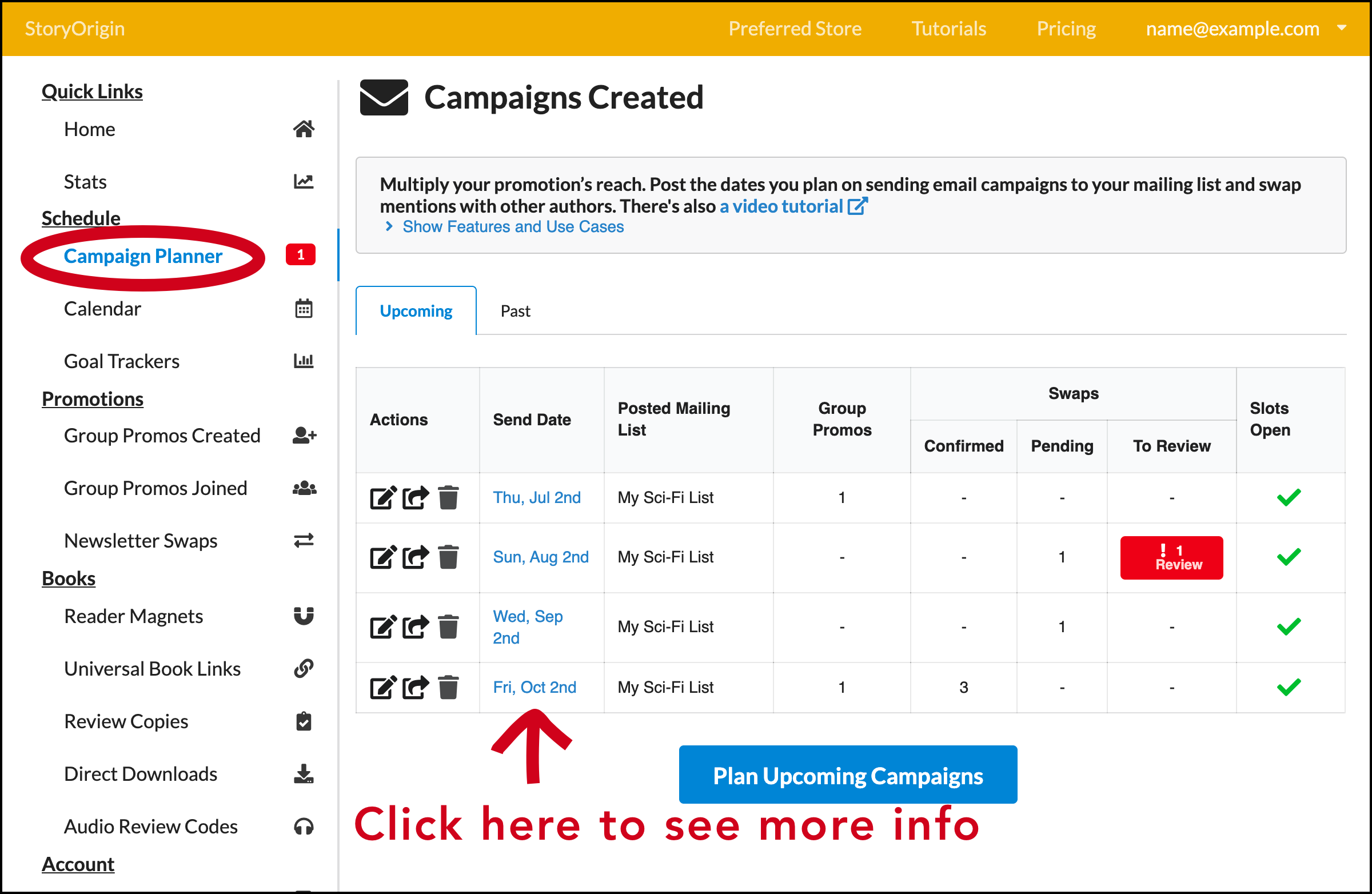
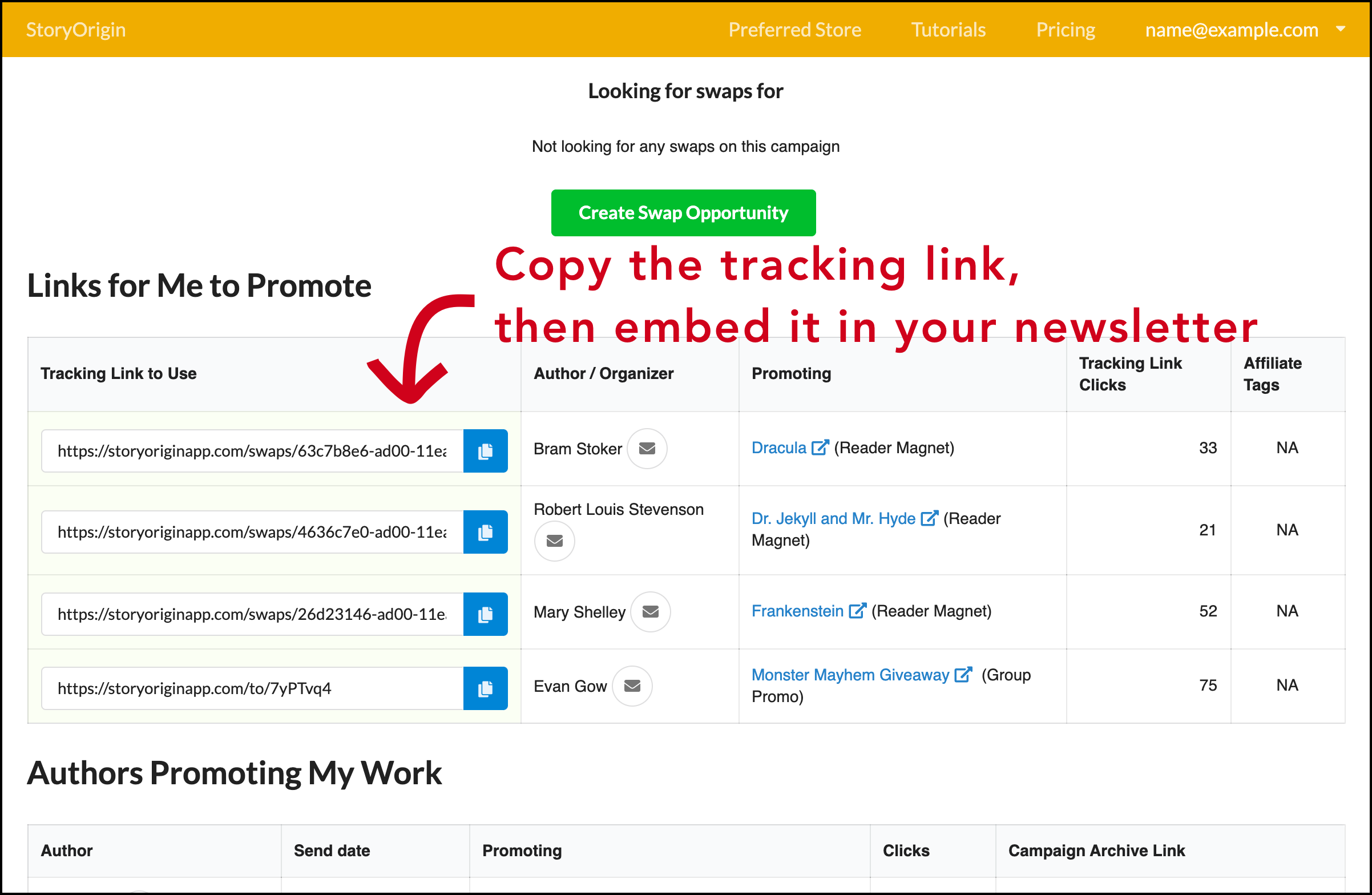
The Campaign Planner feature makes things nice by keeping all of the links that you need to promote in your newsletter on a single page.
However, if you're not using the Campaign Planner feature on StoryOrigin, then you can find your tracking link if you:
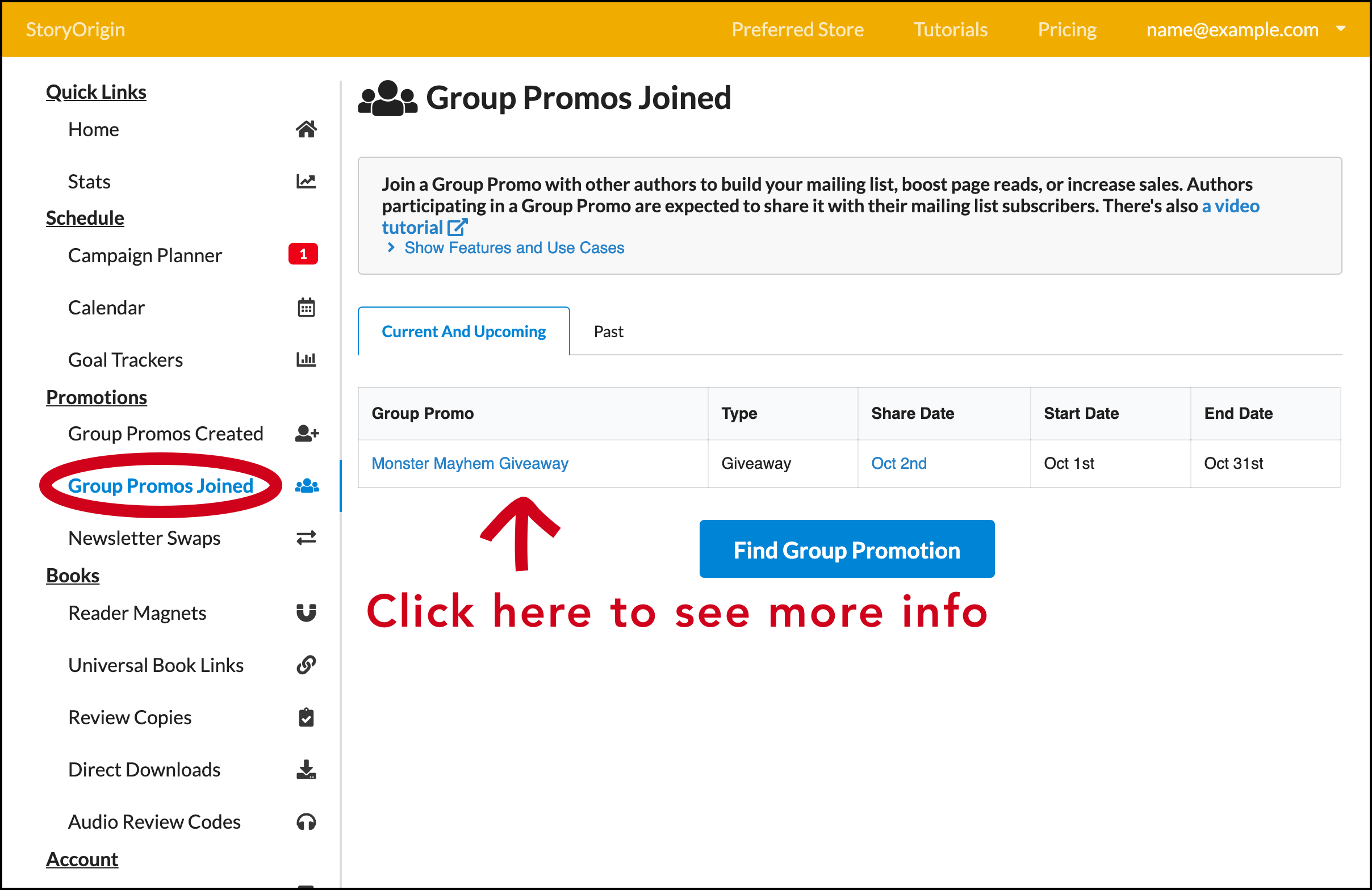
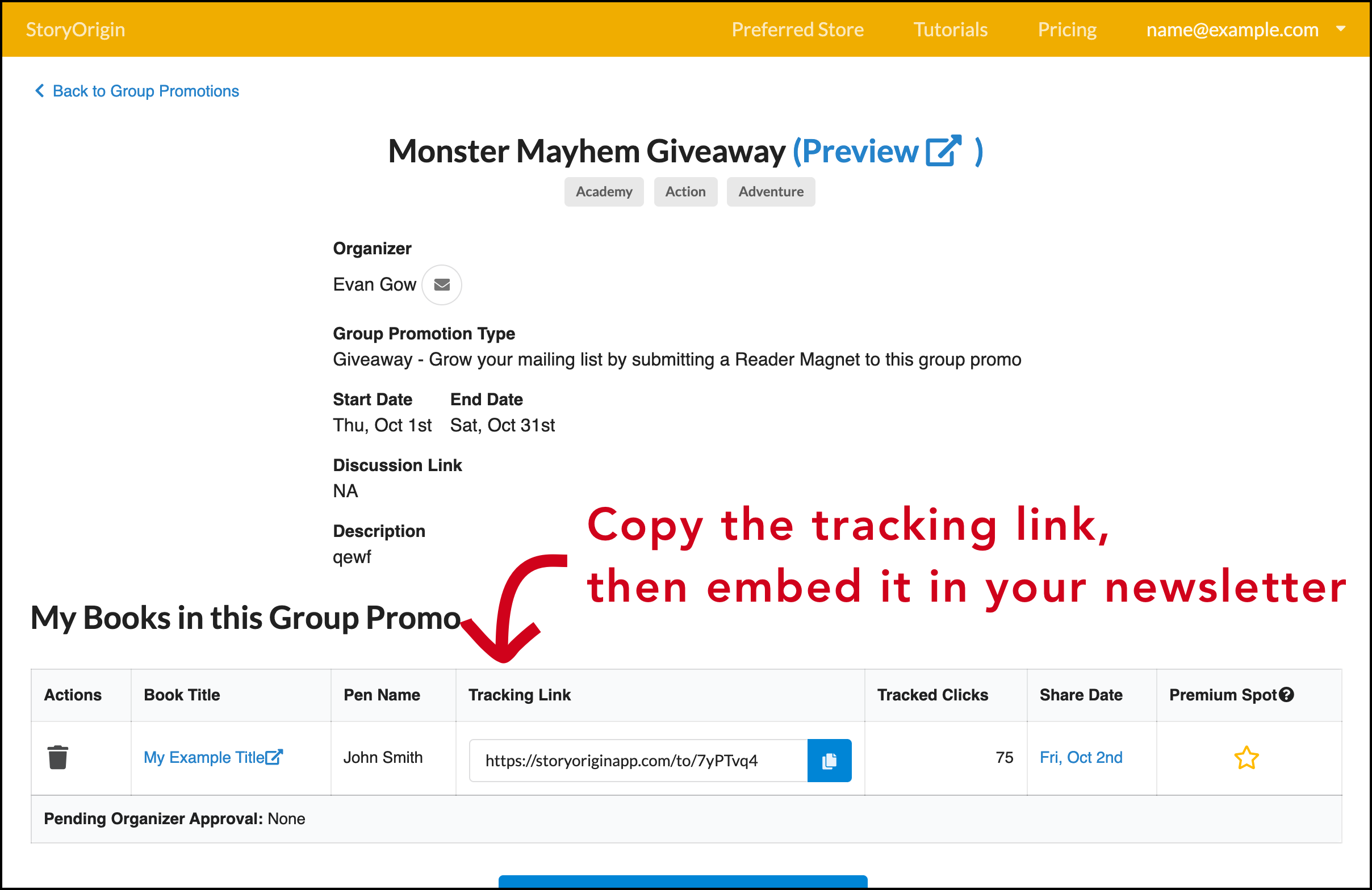
When you arrange or join a newsletter swap or group promo on StoryOrigin, you will get a "tracking link" that is specific to you.
Tracking links count the number of clicks that you send to the landing page you're promoting.
Using this link is important as the other authors you cross-promote with on StoryOrigin can see how many clicks you send.
This transparency reduces the number of people that would otherwise be free-riders (i.e. people who don't uphold their end of a cross-promotion).
When you've got your info and tracking links ready to drop into your newsletter, it's time to design your email.
I recommend splitting your newsletter into two sections with personal, general interest and community content first, then promotions second.
I recommend this ordering, so that when people open your email, they aren't immediately distracted with links away from your own content.
Let's take a look at the example below to see what this might actually look like.
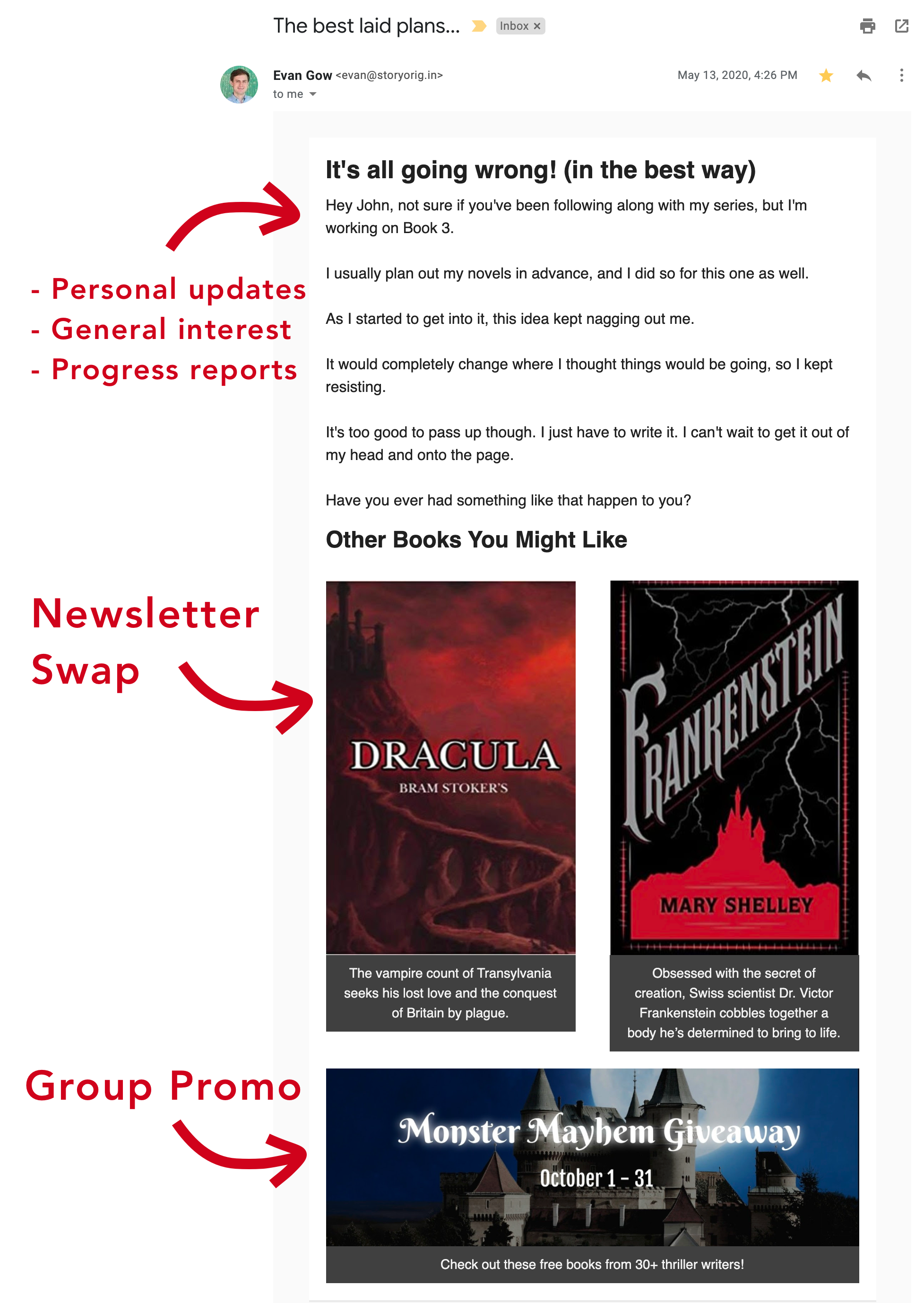
It's worth noting a couple of things from the example above.
First, the personal content section isn't nearly as engaging as you would want your real newsletter to be.
Second, in the sections where we listed promotions, we're not saying endorsing them, reviewing them, or providing testimonials.
We've titled that section "Other books you might like" as it's up to the reader to check them out.
You can think about promos like the “also-bought” section on Amazon where Amazon makes it easy to discover other books related to the one that the reader is currently viewing.
You can also see in this section that newsletter swaps and group promos are different.
For newsletter swaps, you normally include the book cover into your newsletter, but you can add more information like pricing, blurbs, etc.
The image below shows how you would want to embed the link such that clicking the book cover will take you directly to the landing page for that single book.
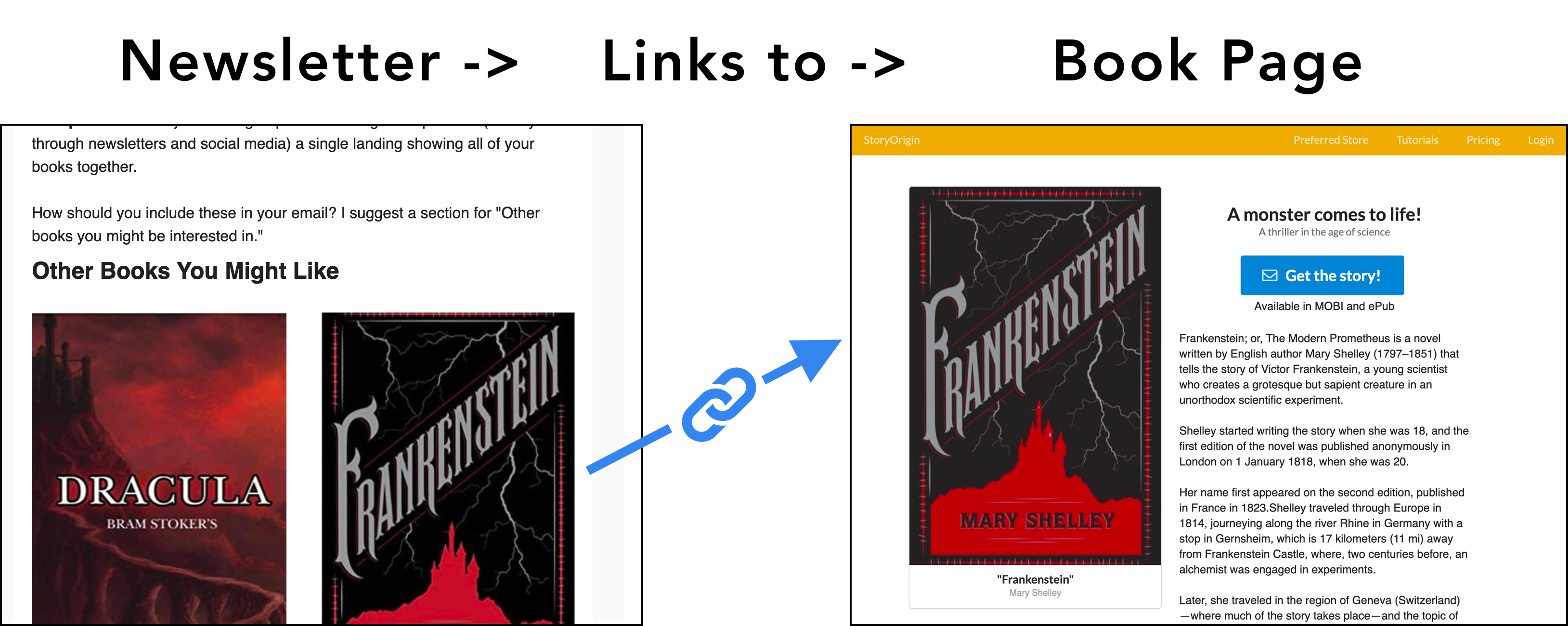
For group promos, you normally include the banner image in your newsletter, but you can add a description of the theme or the type of group promo as well. As you can see below,
The image below shows how you would want to embed the link such that clicking the banner image will take you directly to the landing page listed all of the participating authors' books.
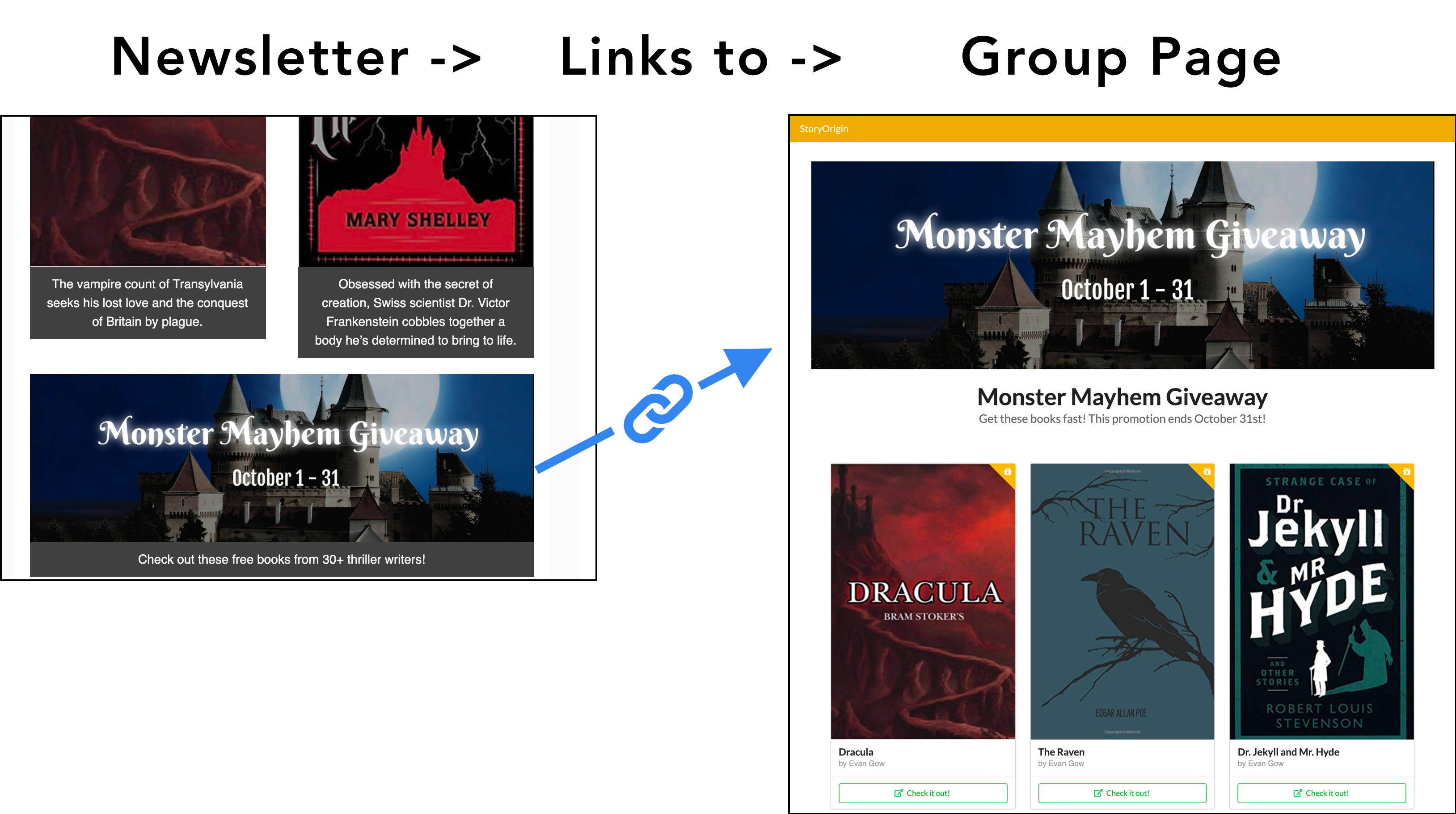
When you are embedding the links to newsletter swaps and group promos that your arrange or join on StoryOrigin, make sure to use the "tracking link" you receive for that cross-promotion.
Using your tracking links are important as they notify they're the main way other authors know when you've sent out your newsletter and how many clicks you've sent.
Avoid setting up so many cross-promos, such that you only send 1 or 2 clicks to other authors.
Speaking of the number of swaps you might have in your newsletter...
I recommend participating in a maximum of 3 group promos and a maximum of 6 newsletter swaps for each newsletter you send out.
The balancing act is to make sure that you're sending each promotion a decent number of clicks.
On StoryOrigin organizers and newsletter swappers can see how many clicks you sent to a cross-promotion, and you have a reputation to uphold.
If you jam your newsletter with too many cross-promotions, each one will suffer and it will look like you're not pulling your weight as a participant.
Organizers and swappers know if you have a small mailing list, you're not going to send hundreds of clicks, but it should be commensurate with the size of your audience.
Absolutely. There's a strong positive correlation between authors that organize group promos and the number of sign ups and clicks that they get.
Why?
Books in a group promo are arranged randomly on each visit to the landing page. So, if you joined a group promo, each time a reader visits that page your book could end up near the top or near the bottom.
However, as a group promo organizer on StoryOrigin, you can set books in a group promo to get “premium spots.”
Books with premium spots have two advantages: 1) they are displayed first on the landing page for the group promo, and 2) the book covers are also enlarged. These advantages mean books with premium spots get more visibility.
If you organize group promos, then you can give your books those premium spots.
As the organizer, it's also much easier to build relationships with multiple other authors in your genre simultaneously. These connections may be helpful if you're looking to set up newsletter swaps or find co-authors or just a support network.
If you have a small mailing list, all the values of a group promo are amplified and you can also feel good about doing something for the indie author community.
As the organizer, you can think of running the group promotion and recruiting authors to join as your contribution if your mailing list is still small and you won't be able to send much traffic to it.
Remember, the value of a group promo is positively correlated with the number of authors participating in the group promo.
In other words, if you organize a group promo and only your books are in it, then you're not going to see any real benefit from it.
That means, it's important to find other authors that might want to participate.
How do you find other authors to join a group promo? Post the link for authors to apply across:
Your group promo will also be listed on the StoryOrigin. So, authors who check for group promos on StoryOrigin regularly will see it there as well.
Remember, more authors joining a group promo will usually be better.
With Facebook Groups, it can also be easier to build relationships with other authors in your genre.
Beware though, a Facebook Group post will usually only show up in someone's news feed if the post gets some interaction (comments or likes).
That's why I recommend if you post in cross-promotion groups, you ask a question, such as: “Who would be interested in a list-builder group promo for [XYZ] genre?”
People commenting should give it some more visibility, then you go ahead and create it and share the link in the comments.
Afterwards, you might post a couple different versions of a banner image for the group promo and see which one people like more. That engagement will also help the post get more visibility.
To find royalty-free images for your banner image, you can use free sites like Pixabay or Unsplash, which allow anyone to upload photos. Note, the lack of curation means pictures uploaded there may contain copyrighted or stolen artwork or lack a model release form.
Alternatively, you can use a site like Deposit Photos, which is paid, but curated. They also usually run a deep discount once or twice a year, which makes it worth signing up to their newsletter.
Take your image and add the title or dates of the promotion to the image. If you don't have a photo editor, you can use iPiccy or Canva for free online. Or, use an all-in-one tool like Book Brush to find the image AND spice it up.
Other than finding other authors to join and creating the banner image, the rest of the process is automated by StoryOrigin.
StoryOrigin sends reminder emails the day the group promo starts and sends reminder emails to each author on the day they said they would be sharing it.
Once your email list is set up, and you start gaining subscribers, you have all the flexibility in the world.
Start sending those readers to apply for review copies or audiobook promo codes that you have.
Use your mailing list to participate in group promos for sales or KU page reads.
Engage your readers in a Facebook Group.
Arrange newsletter swaps with other authors.
Sure thing! The list below is what to do if you want to go at it hard and fast. There lots of successful authors that won't necessarily have each of these components (e.g., a Facebook Group).
If you link to anything in the back of your books, always, always, always use a redirect link. Redirect links allow you to change the destination for the URL, so you'll never have to republish your manuscript just because you want change the link at the back of the book.
You can use link shortener services (e.g., Bitly, smartURL, etc) or use StoryOrigin's Custom Links feature to create redirects from your own website domain.
Why?
First, not all e-readers have browsers and even those that do may be outdated.
Second, you can avoid the hassle of changing the links. You may want the link to go to a different book, or to use a different service to host the book, etc.
Recommendation 1) Tell readers to visit the link from their laptop or smartphone.
Recommendation 2) Do not “embed” the hyperlink in the text. Show the link in full, so readers can type it into a different device.
Recommendation 3) Keep your wording vague, so you can change where the link redirects to.
Recommendation 4) If you are using a custom path for your link, the path should be the title of the book that the link is inserted into.
Let's bring this altogether. Let's say that you have a book titled “My First Book.”
At the end of the “My First Book,” you might say, “Want to get free books in this series? Get on your computer/phone and dive in at authordomain.com/my-first-book”
Again, note that the link path is titled the same as the book that it gets inserted into.
The language is versatile, so you could have this link redirect to a prequel, a side-story, or a page listing multiple reader magnets and other books in the series.
Even if you've followed the advice in this guide and:
You will still have subscribers that don't open any of your emails.
You will still have subscribers that don't open your emails or click on any links.
Depending on the email service provider you're using and their pricing tiers, these subscribers may be costly to keep on your mailing list.
Having a low open rate or click rate on your emails may also degrade your sender reputation and make your emails more likely to end up in the spam folder.
Therefore, it's good to "scrub" your email list occasionally and remove those non-openers from your mailing list.
How long should you wait before you remove someone from your mailing list?
It depends on how frequently you send emails.
If someone hasn't opened an email from you in 2 months, but you only send emails once per month, it's probably worth keeping them on the list for another month.
If someone hasn't opened an email from you in 2 months and you send your emails on a weekly basis, you can be fairly certainly they're never going to open an email from you.
Once you've decided on your criteria, you can create a "segment" from those contacts and remove them from your list.
If you've set a high bar for readers to stay on your list, and feel like you might be removing too many contacts, you can also send a campaign to the segment you created and ask readers to click a button if they would like to remain on your mailing list.
This is called a win-back or re-engagement campaign.
You can post your reader magnet up on StoryOrigin, but should you also publish it to various retailers (e.g., Amazon)?
If you publish your reader magnet, it provides an additional "entry point" for readers to find out about series.
You can also include an encouragement to review the reader magnet in the back matter.
Having a price for your reader magnet also gives you another way to encourage readers to join your mailing list (e.g., "Buy the book for $X.XX or get it free when you join my mailing list!")
Alternatively, you may prefer to only let newsletter subscribers get your reader magnet. This is referred to as as "newsletter exclusive."
The benefit to keeping it a newsletter exclusive is that it provides a way to get readers on your mailing list that otherwise wouldn't join if they could buy the reader magnet.
This is just a hunch, but readers that would rather buy the book than get it for free by joining your mailing list might be your most valuable readers - the kind that would buy anything you write.
You might just be able to have your cake and eat it too though.
Rather than having only a single reader magnet for your series, create multiple.
Recommendation 1) Publish your prequel short story reader magnet wide and use it as an entrance to the series that can get traffic from various retailers.
Recommendation 2) Write one or multiple side-stories to use as reader magnets that you keep as newsletter exclusives.
Side-stories are usually written for an audience that is already familiar with the series; thus, they don't make as much sense to publish in order to build traffic to the series.
However, side-stories are a great way to figure out who your super fans are.
Recommendation 3) Regardless of whether you post the book to various retailers or keep it a newsletter exclusive, one thing that you should do regardless is get it posted on Goodreads and Bookbub where readers can leave reviews of the book.
You might be able to get some good quotes from these reviews to use in ads or get a small amount of traffic from the review pages.
It depends.
I recommend using Facebook ads when:
In that case, running Facebook ads can be a great way to build your mailing list using a reader magnet.
Before you have those things under your belt, you will most likely (though not necessarily) be burning your money.
However, if you've never run a book launch before and only have your reader magnet landing page to experiment with, it can be a great learning experience to try running some Facebook ads to learn your way around the system and get a sense for what kind of targeting, ad copy, and images work for you.
Many people organize list-building around "organic" vs. "inorganic" sign-ups.
An organic sign-up is when a reader naturally finds your sign-up link via your book's backmatter or by having searched for your website, etc.
An inorganic sign-up is when a reader finds and signs up to your mailing list through advertising.
Between these 2 definitions, organic signs up are certainly more valuable, but inorganic sign-ups can be acquired in many ways and vary greatly in value.
That's why I like to break sign-ups down by interest (listed below - ranging from most to least valuable).
When evaluating marketing tactics, it's important to consider your target audience's motivation.
You can see how raffles might lead to building a mailing list with a low open and click rate. Those subscribers might just be interested in the prize - not your writing.
Not all raffles are created equal though. The prizes you put up for your raffle matter.
Running raffles for Amazon gift cards as a way to build your mailing list may get you a ton of sign-ups, but there's little to guarantee those readers even like your genre let alone your books.
If you do run raffles, you can target your audience by making sure the prizes match up with your audience's interest.
For example, if you write sci-fi, find comparable / popular books in your genre and raffle off paperback versions of those books.
These sign-ups won't be as valuable as those that sign up to your mailing list specifically to get a book written by you, but they will be better than the sign-ups you get from a cash prize.
You're certainly going to have people who subscribe to your mailing list in order to get your reader magnet, but won't buy anything.
There's a long list of reasons why that might be the case:
The list goes on, but what can we do about it?
First thing is: you can be more aggressive about who makes it from your welcome sequence onto your main list.
For example, instead of moving everyone that stays subscribed through the welcome sequence, you could just move subscribers to the main list if they've actually opened one or multiple of your welcome sequence emails.
People who subscribed just to get your reader magnet are most likely non-openers, so removing them more quickly keeps your list lean and engaged.
If your newsletter has high open rates, then you might just need to wait.
It takes time to build relationships with readers and to get them excited to commit to your universe.
Take a look hard look at your emails and ask yourself if you would open them, read them, and click on the links?
Do they actually appeal to you on a personal level?
Assuming your subject lines and content are good, you're getting high open rates and click rates, what else can you do?
Try a weed out strategy.
Have only a single call-to-action in an email campaign.
If the reader doesn't click on the single call-to-action in any of these emails, they might not be your target audience.
Be wary of running newsletters like these too frequently though.
If you're asking your readers to do something for you every time you send an email, you may come off as being too sales-y.
At the end of the day, subscribers stay on your mailing list, because they want to hear from you and get a heads up when you have a new release.
They don't want to be bomarded with a sales pitch every time you email them.
Remember that even readers that don't make purchases can still be useful.
You may get them to join your review team.
Or, you may be running your book for free on Amazon for a few select days as a way to push your book up the top 100 free list.
A spot in the top 100 can get your book in front of readers that aren't on your mailing list, and these readers buy your follow-up books, leave a review of the free book, or join your mailing list from a link in the back matter.
If you're feeling that your newsletter still isn't working for you, just remember that email is still the only real direct line of communication that you have to your readers.
Email is hard to replace and most other places readers might follow you (e.g., a Facebook page) is usually going to have much worse reach and engagement.
About the author: Evan is the founder of StoryOrigin, a marketing tool for authors